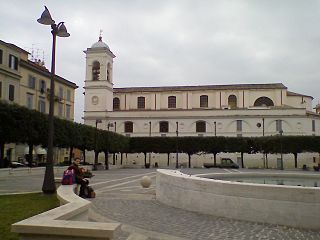The seven suburbicarian dioceses are Catholic dioceses located in the vicinity of Rome, whose (titular) bishops are the ordinary members of the highest-ranking order of cardinals, the cardinal bishops. Pope Francis has, in addition, co-opted five cardinals of the Latin Church to join the ranks of the Cardinal-Bishops.

The dean of the College of Cardinals presides over the College of Cardinals in the Roman Catholic Church, serving as primus inter pares. The position was established in the 12th century. He always holds the rank of a cardinal bishop, and is assisted by a vice-dean. Both are elected by and from the cardinal bishops who are not Eastern Catholic patriarchs, with their election subject to papal confirmation. Except for presiding over the college, the dean and vice-dean have no power over the other cardinals. In the order of precedence in the Catholic Church, the dean and vice-dean, as the two most senior cardinals, are placed second and third, respectively, after the pope.

The Roman Catholic Suburbicarian Diocese of Ostia is an ecclesiastical territory located within the Metropolitan City of Rome in Italy. It is one of the seven suburbicarian dioceses. The incumbent Bishop is cardinal Giovanni Battista Re. Since 1150, its bishop has been the Dean of the College of Cardinals, Its Cathedral is Basilica di Sant'Aurea.

The Diocese of Sabina–Poggio Mirteto is a Latin suburbicarian see of the Holy Roman Church and a diocese of the Catholic Church in Italy in the Roman province of the Pope.

The Diocese of Albano is a Latin suburbicarian see of the Diocese of Rome in Italy, comprising seven towns in the Province of Rome. Albano Laziale is situated on the Appian Way some 15 kilometers from Rome.

The Diocese of Porto–Santa Rufina is a Latin suburbicarian diocese of the Diocese of Rome and a diocese of the Catholic Church in Italy. It was formed from the union of two dioceses. The diocese of Santa Rufina was also formerly known as Silva Candida.

The Diocese of Frascati is a Latin suburbicarian see of the Diocese of Rome and a diocese of the Catholic Church in Italy, based at Frascati, near Rome. The bishop of Frascati is a Cardinal Bishop; from the Latin name of the area, the bishop has also been called Bishop of Tusculum. Tusculum was destroyed in 1191. The bishopric moved from Tusculum to Frascati, a nearby town which is first mentioned in the pontificate of Pope Leo IV. Until 1962, the Cardinal-Bishop was concurrently the diocesan bishop of the see. Pope John XXIII removed the Cardinal Bishops from any actual responsibility in their suburbicarian dioceses and made the title purely honorific.

The Suburbicarian Diocese of Velletri–Segni' is one of the Latin suburbicarian dioceses, Catholic dioceses in Italy close to Rome with a special status and a cardinal bishop, the bishop of Velletri–Segni. Historically, the see of Velletri was combined with the see of Ostia from 1060 to 1914.

Giovanni Antonio Sangiorgio was an Italian canon lawyer and Cardinal. Agostino Oldoino calls him the leading jurisconsult of his age. Kenneth Pennington has called him one of the ‘last two great commentators on feudal law’.

Francesco Pisani was an Italian Cardinal, born in Venice, the son of Alvise Pisani the noted banker, who was Procurator of S. Mark's, a member of the Council of Ten, and a Councilor of the Doge of Venice; and Cecilia Giustinian. He had a brother named Giovanni (Zuan), who also became Procurator of S. Marks' and was a Venetian diplomat; he was married to the sister of Doge Andrea Gritti. He was a strong supporter of the alliance between Venice, France and the Papacy, called the League of Cognac. He shared the imprisonment of Pope Clement VII in the Castel S. Angelo during the Sack of Rome and its aftermath. He spent eighteen months in exile in Naples while Clement made his peace with the Emperor Charles V.
Giovanni Antonio Serbelloni was an Italian Cardinal.

The Diocese of Tivoli is a Latin Church ecclesiastical territory or diocese of the Catholic Church in Latium, Italy, which has existed since the 2nd century. In 2002 territory was added to it from the Territorial Abbey of Subiaco. The diocese is immediately exempt to the Holy See.

Pope Alexander VI created 43 new cardinals in 9 consistories:
Pope Urban V (1362–1370) thirteen new cardinals in four consistories.

Pope Leo X created 42 new cardinals in eight consistories.

Pope Sixtus IV created 34 new cardinals in eight consistories:

Pope Sixtus V created 33 new cardinals in eight consistories:

Pope Clement VII created 32 new cardinals:

Pope Pius IV created 46 cardinals in four consistories:
Pope Eugene IV (1431–1447) created 27 cardinals in six consistories.

















